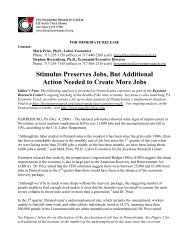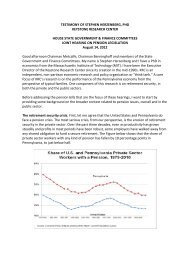The State of Working Pennsylvania 2004 - The Keystone Research ...
The State of Working Pennsylvania 2004 - The Keystone Research ...
The State of Working Pennsylvania 2004 - The Keystone Research ...
Create successful ePaper yourself
Turn your PDF publications into a flip-book with our unique Google optimized e-Paper software.
<strong>The</strong> <strong>State</strong> <strong>of</strong> <strong>Working</strong> <strong>Pennsylvania</strong> <strong>2004</strong> 16<br />
that recession ended the labor force was only 0.7 percent higher than when that recession began.<br />
Since March 2001, Jobs 181,000 Short <strong>of</strong> Keeping Pace with <strong>Working</strong>-Age<br />
Population<br />
One way to measure the adequacy <strong>of</strong> job growth is to compare it with the growth <strong>of</strong> the workingage<br />
population. <strong>The</strong> growth <strong>of</strong> this population is a rough measure <strong>of</strong> the growth in the number <strong>of</strong><br />
people who want jobs. It has the advantage <strong>of</strong> not being influenced by hard-to-interpret movements<br />
<strong>of</strong> people in and out <strong>of</strong> the labor force.<br />
<br />
<br />
<br />
<br />
<br />
<br />
<br />
<br />
<br />
<br />
<br />
<br />
<br />
<br />
<br />
<br />
Using population-growth estimates developed by the economic forecasting firm Economy.com,<br />
the Economic Policy Institute (EPI) reports that the <strong>Pennsylvania</strong> working-age population (ages<br />
20-64) grew by 1.7 percent between the start <strong>of</strong> the recession and July <strong>2004</strong>. This compares with<br />
a 1.3 percent decline in the number <strong>of</strong> jobs over the same period. (<strong>The</strong> EPI data are online at<br />
www.jobwatch.org/<strong>2004</strong>0820state_job_growth_pop_growth.pdf.) If the rate <strong>of</strong> job growth since the<br />
recession began had kept up with the rate <strong>of</strong> working-age population growth, <strong>Pennsylvania</strong> would<br />
have had approximately 181,000 more jobs in July <strong>2004</strong>.<br />
<strong>Pennsylvania</strong> Manufacturing Wages Lower<br />
<br />
<br />
<br />
<br />
<br />
Recent national reports have highlighted the stagnation <strong>of</strong> the inflation-adjusted wages <strong>of</strong> nonsupervisory<br />
workers in the U.S. economy. <strong>The</strong> only available data on <strong>Pennsylvania</strong> non-supervisory<br />
workers in <strong>2004</strong> are for the average hourly earnings <strong>of</strong> production workers in manufacturing.<br />
Because these data are not seasonally adjusted the only comparisons that can be made since the







